
How to Use SOIL SENSOR 4IN1 RS485 THCPH-S: Examples, Pinouts, and Specs
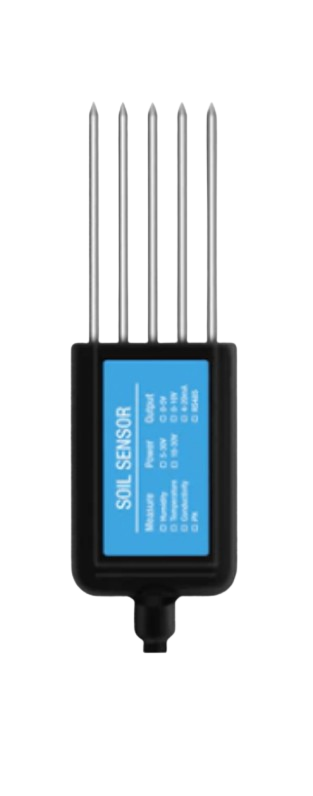
 Design with SOIL SENSOR 4IN1 RS485 THCPH-S in Cirkit Designer
Design with SOIL SENSOR 4IN1 RS485 THCPH-S in Cirkit DesignerIntroduction
The SOIL SENSOR 4IN1 RS485 THCPH-S is a versatile and high-precision soil sensor designed to measure four critical soil parameters: moisture, temperature, pH, and electrical conductivity (EC). It utilizes RS485 communication for robust and reliable data transmission, making it suitable for a wide range of agricultural, horticultural, and environmental monitoring applications.
Explore Projects Built with SOIL SENSOR 4IN1 RS485 THCPH-S
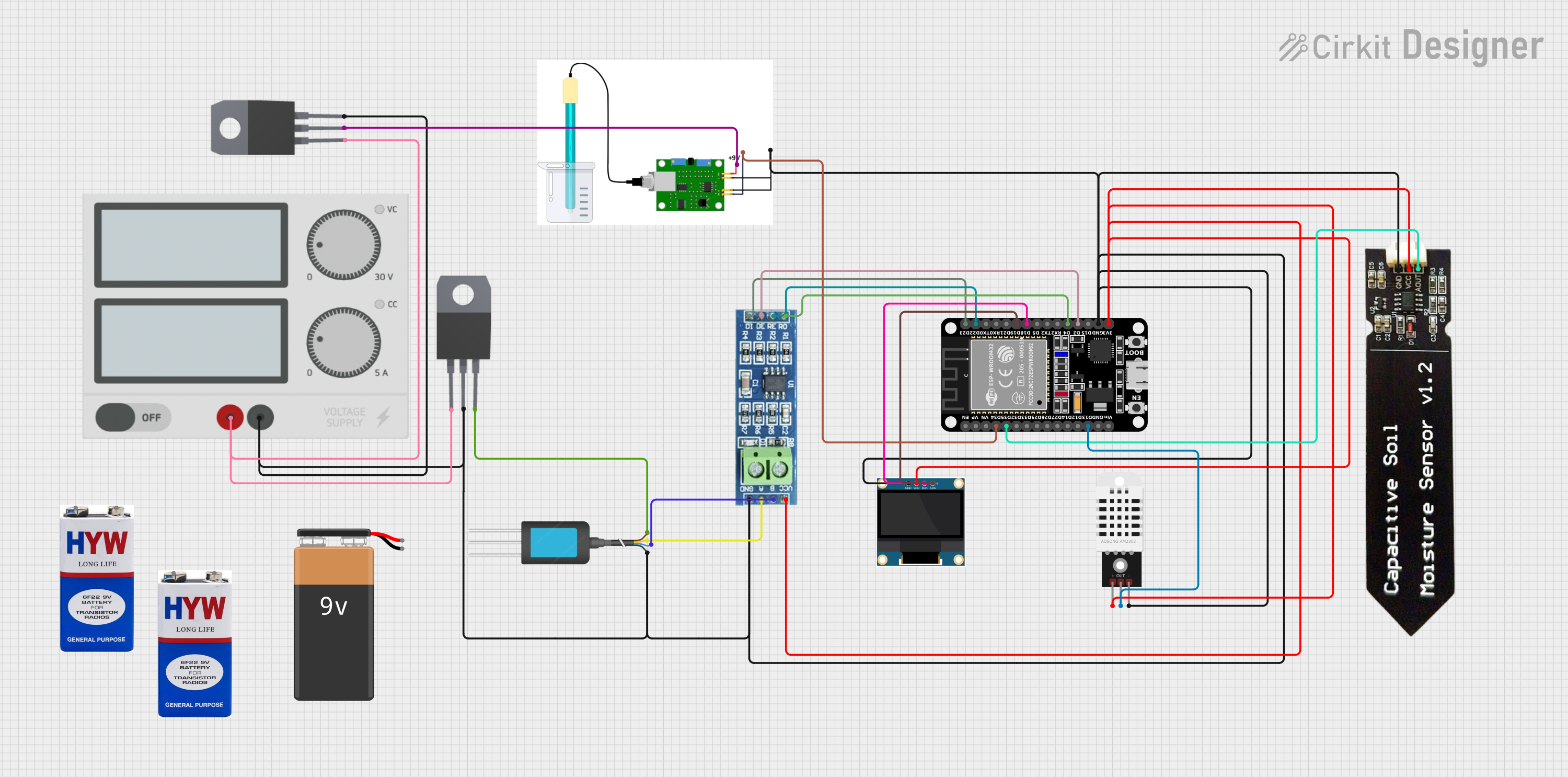
 Open Project in Cirkit Designer
Open Project in Cirkit Designer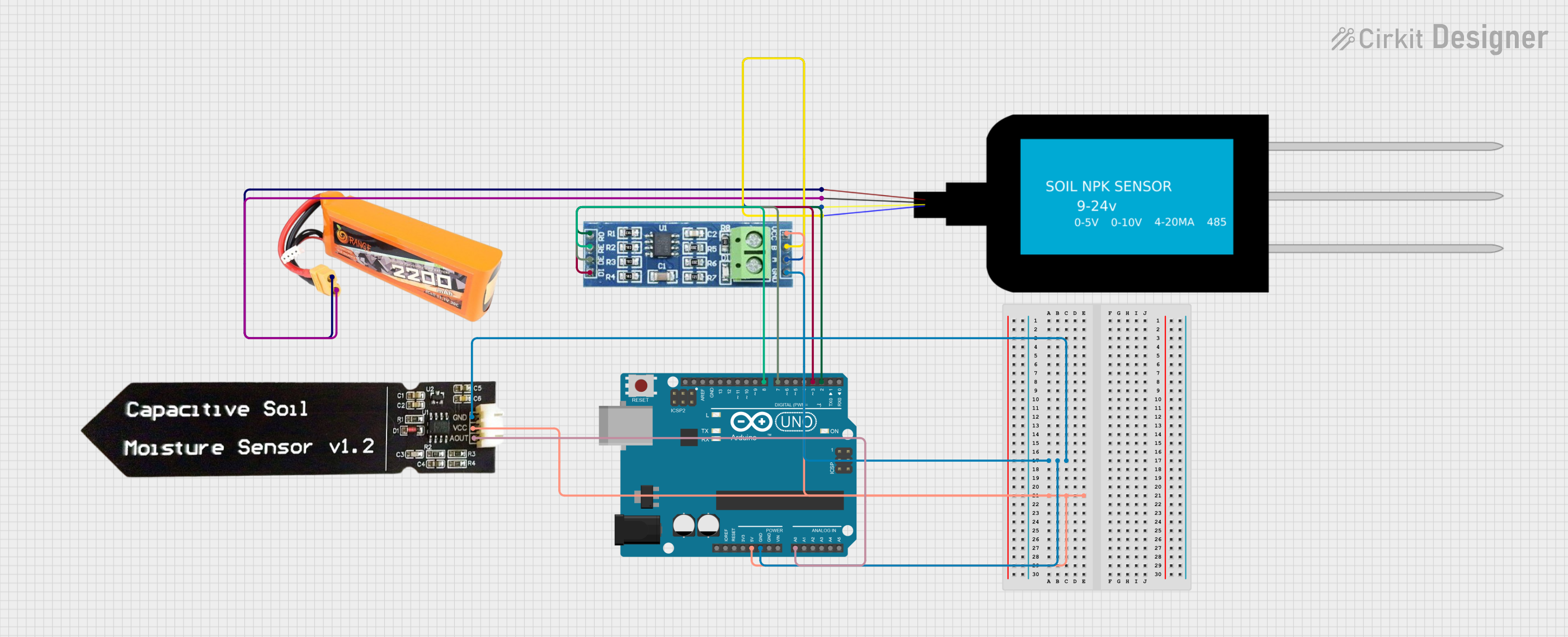
 Open Project in Cirkit Designer
Open Project in Cirkit Designer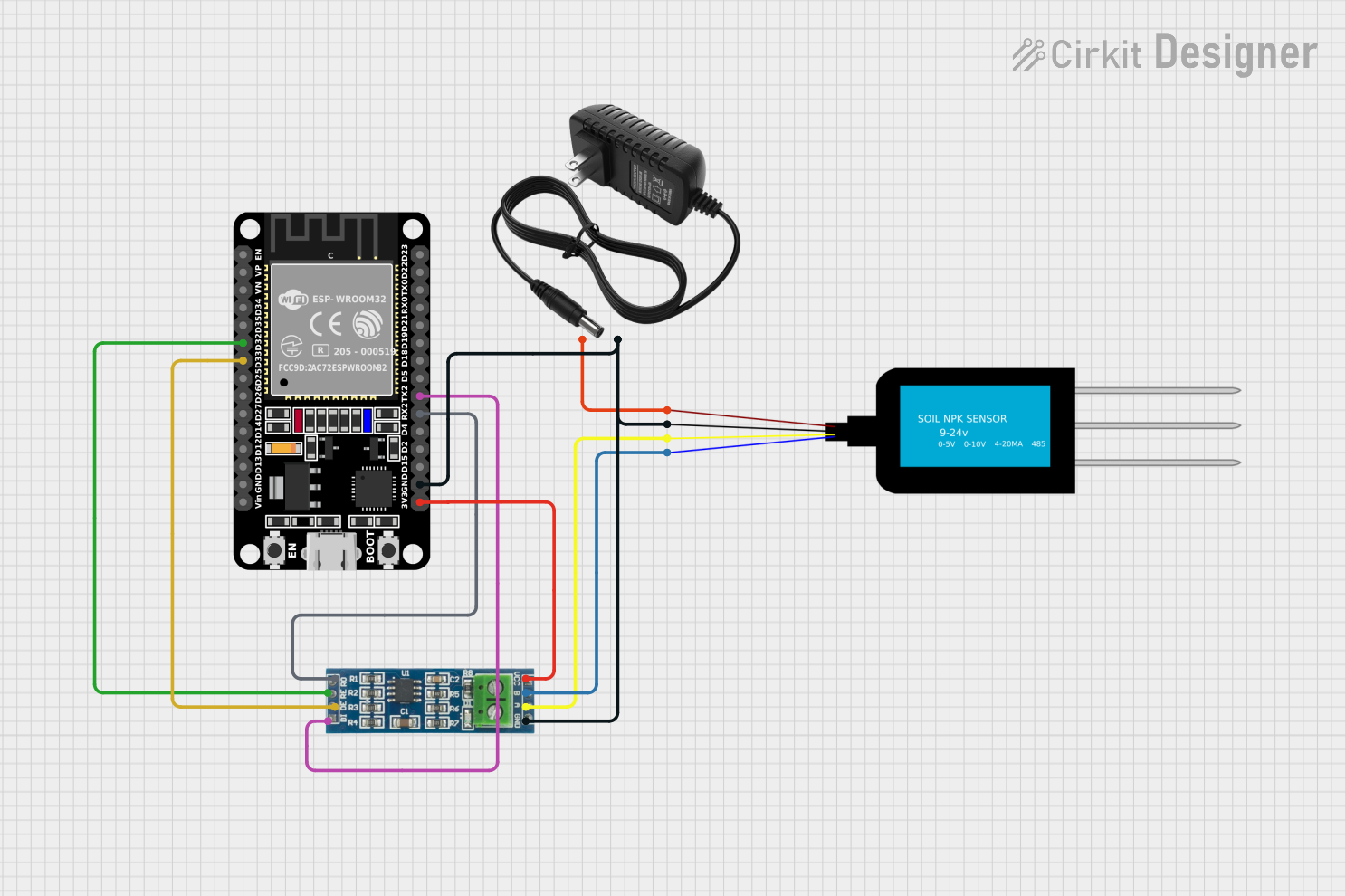
 Open Project in Cirkit Designer
Open Project in Cirkit Designer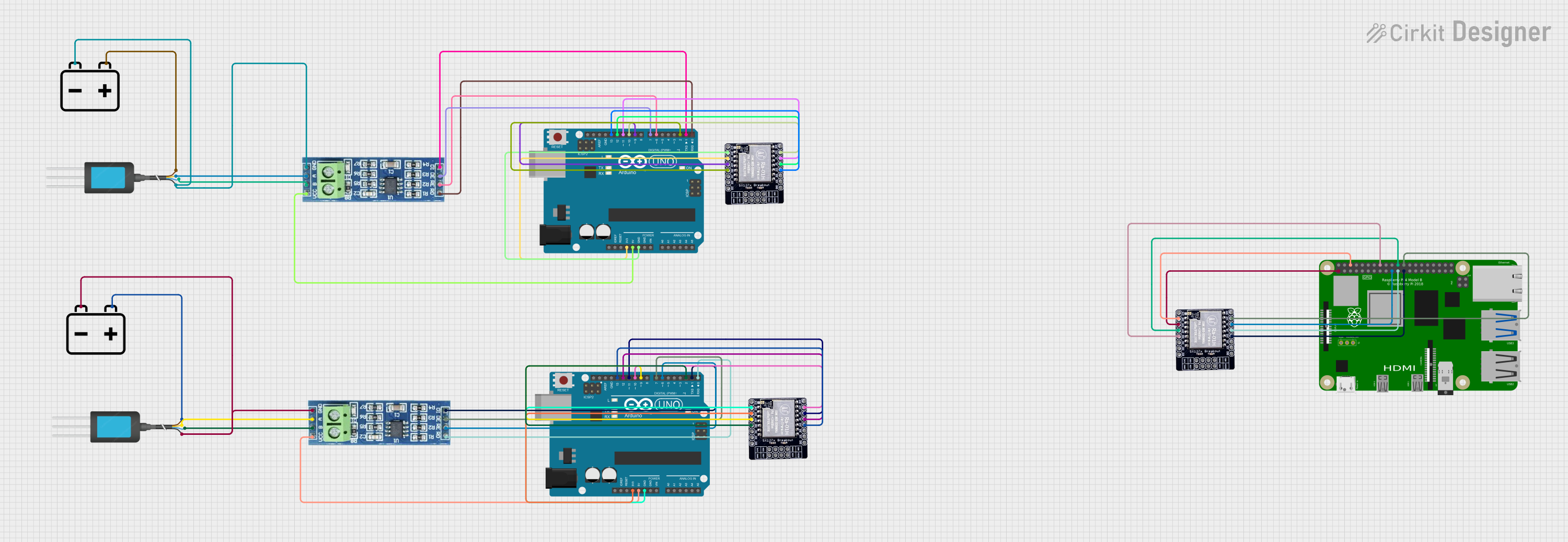
 Open Project in Cirkit Designer
Open Project in Cirkit DesignerExplore Projects Built with SOIL SENSOR 4IN1 RS485 THCPH-S

 Open Project in Cirkit Designer
Open Project in Cirkit Designer
 Open Project in Cirkit Designer
Open Project in Cirkit Designer
 Open Project in Cirkit Designer
Open Project in Cirkit Designer
 Open Project in Cirkit Designer
Open Project in Cirkit DesignerCommon Applications and Use Cases
- Precision agriculture for optimizing irrigation and fertilization
- Greenhouse monitoring and control systems
- Soil quality analysis in research and development
- Environmental monitoring for land management
- Smart farming and IoT-based agricultural systems
Technical Specifications
The following table outlines the key technical details of the SOIL SENSOR 4IN1 RS485 THCPH-S:
| Parameter | Specification |
|---|---|
| Manufacturer | SOIL SENSOR |
| Part ID | THCPH-S |
| Communication Protocol | RS485 |
| Power Supply Voltage | 9V to 24V DC |
| Power Consumption | ≤ 0.5W |
| Measurement Parameters | Soil Moisture, Temperature, pH, EC |
| Moisture Range | 0% to 100% |
| Temperature Range | -40°C to 80°C |
| pH Range | 3.0 to 9.0 |
| EC Range | 0 to 20 mS/cm |
| Accuracy | ±2% (Moisture), ±0.5°C (Temperature), ±0.1 (pH), ±2% (EC) |
| Output Format | Modbus RTU |
| Cable Length | 2 meters (extendable) |
| Waterproof Rating | IP68 |
Pin Configuration and Descriptions
The sensor has a 4-wire interface for power and communication. The pin configuration is as follows:
| Pin | Wire Color | Description |
|---|---|---|
| 1 | Red | Power Supply (9V to 24V DC) |
| 2 | Black | Ground (GND) |
| 3 | Yellow | RS485-A (Data Line A) |
| 4 | Blue | RS485-B (Data Line B) |
Usage Instructions
How to Use the Component in a Circuit
- Power Connection: Connect the red wire to a DC power supply (9V to 24V) and the black wire to ground.
- RS485 Communication: Connect the yellow (RS485-A) and blue (RS485-B) wires to the RS485 interface of your microcontroller or RS485-to-USB converter.
- Modbus RTU Configuration: Configure your microcontroller or software to communicate with the sensor using the Modbus RTU protocol. The default baud rate is 9600 bps.
- Data Reading: Use Modbus commands to query the sensor for soil moisture, temperature, pH, and EC data.
Important Considerations and Best Practices
- Ensure the sensor is fully inserted into the soil for accurate measurements.
- Avoid placing the sensor in highly acidic or alkaline environments outside its pH range (3.0 to 9.0).
- Use a shielded cable for RS485 communication to minimize interference in noisy environments.
- Calibrate the sensor periodically for pH and EC measurements to maintain accuracy.
- Protect the sensor from physical damage during installation and use.
Arduino UNO Example Code
Below is an example of how to interface the SOIL SENSOR 4IN1 RS485 THCPH-S with an Arduino UNO using an RS485 module:
#include <ModbusMaster.h>
// Instantiate ModbusMaster object
ModbusMaster node;
// RS485 communication pins
#define RE_DE_PIN 2 // Pin to control RS485 module (RE/DE)
// Function to control RS485 module direction
void preTransmission() {
digitalWrite(RE_DE_PIN, HIGH); // Enable transmission
}
void postTransmission() {
digitalWrite(RE_DE_PIN, LOW); // Enable reception
}
void setup() {
// Initialize serial communication
Serial.begin(9600);
Serial.println("SOIL SENSOR 4IN1 RS485 THCPH-S");
// Initialize RS485 control pin
pinMode(RE_DE_PIN, OUTPUT);
digitalWrite(RE_DE_PIN, LOW);
// Initialize Modbus communication
node.begin(1, Serial); // Sensor Modbus ID is 1
node.preTransmission(preTransmission);
node.postTransmission(postTransmission);
}
void loop() {
uint8_t result;
uint16_t data[4];
// Read 4 registers starting from address 0x0000
result = node.readInputRegisters(0x0000, 4);
if (result == node.ku8MBSuccess) {
// Store the data
data[0] = node.getResponseBuffer(0); // Moisture
data[1] = node.getResponseBuffer(1); // Temperature
data[2] = node.getResponseBuffer(2); // pH
data[3] = node.getResponseBuffer(3); // EC
// Print the data
Serial.print("Moisture: ");
Serial.print(data[0]);
Serial.println("%");
Serial.print("Temperature: ");
Serial.print(data[1] / 10.0); // Convert to °C
Serial.println("°C");
Serial.print("pH: ");
Serial.print(data[2] / 10.0); // Convert to pH
Serial.println();
Serial.print("EC: ");
Serial.print(data[3] / 100.0); // Convert to mS/cm
Serial.println(" mS/cm");
} else {
Serial.print("Error reading sensor: ");
Serial.println(result, HEX);
}
delay(2000); // Wait 2 seconds before next reading
}
Troubleshooting and FAQs
Common Issues and Solutions
No Data Received from the Sensor
- Ensure the RS485-A and RS485-B wires are correctly connected to the RS485 module.
- Verify that the sensor's Modbus ID and baud rate match your configuration.
- Check the power supply voltage (9V to 24V DC) and ensure it is stable.
Inaccurate Measurements
- Ensure the sensor is fully inserted into the soil and free from debris.
- Calibrate the sensor for pH and EC measurements if readings are inconsistent.
- Avoid using the sensor in extreme environmental conditions outside its specified ranges.
Communication Errors
- Use a shielded cable for RS485 communication to reduce interference.
- Verify the termination resistor (120Ω) is properly installed at the end of the RS485 bus.
FAQs
Q: Can the sensor be used underwater?
A: Yes, the sensor is IP68-rated and can be submerged in water, but it is designed primarily for soil applications.
Q: How often should the sensor be calibrated?
A: Calibration frequency depends on usage, but it is recommended to calibrate the pH and EC measurements every 6 months for optimal accuracy.
Q: Can the sensor be used with other microcontrollers?
A: Yes, the sensor can be used with any microcontroller that supports RS485 communication and Modbus RTU protocol.